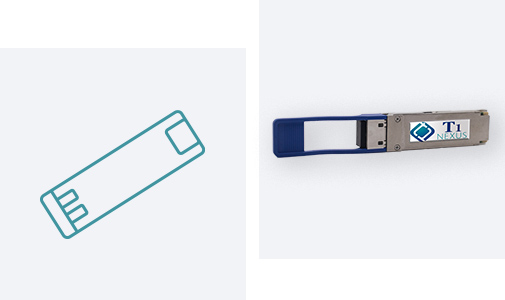Optical Transceivers
Designed to support high-performance computing environments

A Wide Range of Multi-coded Optical Transceivers
QUALITY & WARRANTY
ISO and TL9000 Quality with a Lifetime Warranty
We are proud to offer industry-leading products that meet ISO and TL9000 standards and are backed by a lifetime warranty.
Get the T1Nexus Advantage
Access to an extensive product portfolio
Deep technical expertise for optimal results & always-available technical support for quick resolutions
Ongoing reliability testing
Custom products and rapid prototyping capabilities
A flexible fulfillment model to support your business
Deep joint venture relationships with manufacturing partners in Taiwan and across Asia for guaranteed product assurance
Optical Transceivers FAQs
Optical transceivers work by converting electrical signals into light signals for transmission over fiber optic cables, and then converting the light signals back into electrical signals upon receipt. They consist of a transmitter and a receiver, both of which are connected to the same fiber optic cable at each end.
The transmitter converts the electrical signals into light signals using a laser or light-emitting diode (LED), which then travels through the fiber optic cable to the receiver. The receiver contains a photodetector that converts light signals received back into electrical signals.
Optical transceivers can operate also at different wavelengths of light, allowing multiple data streams to be transmitted simultaneously over the same fiber optic cable. They also use a variety of modulation techniques to encode data onto the light signals, allowing for higher data rates.
Optical transceivers are commonly distinguished by form factor and distance. The following are the most common transceiver form factors available today:
- OSFP or Octal Small Form Factor Pluggable provides eight high-speed electrical lanes capable of supporting 400Gbps data rates.
- QSFP or Quad Small Form Factor Pluggable supports up to 1Gbps data rates for each of the four channels available.
- QSFP28 (100G) or Quad Small Form Factor Pluggable 28 supports up to 100 Gbps data rates. It is capable of up to 28 Gbps data rates, hence the “28” designation.
- QSFP-DD - or Quad Small Form Factor Pluggable - Double Density supports up to 400 Gbps data rates due to the extra four or eight electrical lanes available.
- SFP or Enhanced Small Form-factor Pluggable supports 100/1000Mbps Ethernet, Fibre Channel and SONET, among other communication standards.
- SFP+ or Enhanced Small Form-factor Pluggable Plus is identical to SFP in size, however, is an updated version capable of supporting higher speeds up to 10Gbps.
- SFP28 or Small Form-Factor Pluggable 28 is the third generation of the SFP interconnect systems capable of 28Gbps data rates, hence the “28” designation.
There are four standard transceiver types with their respective transmission distances:
- SR - Short Range, 850nm
- LR - Long Range, 1310nm
- ER - Extended Range, 1550nm
- ZR - Further Extended Reach, 1550nm
Here are three core benefits of using optical transceivers:
Multi-device Compatibility
Pluggable devices, such as SFP transceivers, are highly compatible with different components and setups across fiber optic and copper channels. They ensure universal compatibility and meet Gigabit standards for all network types, regardless of communication distance. This eliminates the need for new hardware when replacing a transceiver, making communication easier and more efficient.
Greater Communication Distances
SFP transceivers enable data transmission across fiber optic networks using copper wiring or fiber optics. Optical transceiver modules also assist in signal delivery for both short and long-distance communication.
High Data Rates
Transceivers come with set speeds that affect data transfer rates. Most modules connected to transceivers transfer data at Gigabit per second rates, typically ranging from 1Gbps to 10Gbps. Faster data rates are necessary for mission-critical applications. Pluggable fiber optic transceivers are also universal, flexible, scalable, and affordable, making them valuable to any network.
Get the T1Nexus Advantage
We are ready to help you identify the right solutions for your organization. Contact us to explore our extensive, high-quality product range today.
Contact Us
Book a Meeting
Have questions about our products or services? Book a meeting and we'll be in touch.
